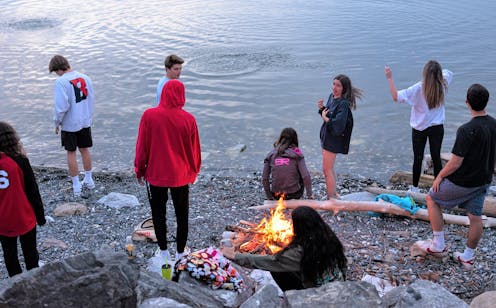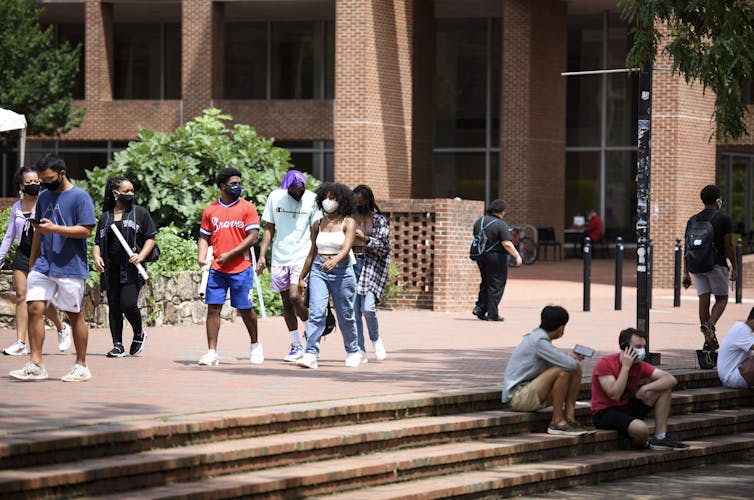Teens want COVID-19 advice that gives them safe ways to socialize – not just rules for what they can
In a series of surveys, young people across the US described their thinking and behavior amid the coronavirus pandemic.

America’s teens and young adults have a crucial role in containing the spread of COVID-19, but a series of youth surveys suggests that many misunderstand social distancing guidelines and want clearer advice on how to safely live their lives.
This is especially relevant now that universities are back in session and many campuses are seeing COVID-19 outbreaks.
Over the last several months, our team at the University of Michigan has conducted several national text-message surveys of over 1,000 American youth ages 14-24 to better understand what they are going through during the pandemic.
What we have learned sheds light on young people’s perspectives and could help improve public health practices.
I can hang out with friends, right?
The responses by young people in our surveys suggest that they are taking the pandemic seriously.
From our surveys starting in March and continuing throughout the summer, we found about three-quarters of young people were feeling some level of anxiety about the pandemic. Many reported following guidelines such as distancing, wearing masks, and staying at home, most often due to their concern for others. These respondents cited the importance of protecting friends, family and high-risk groups. “Not so much for my own health but for my parents and grandparents,” one wrote.
However, as youth described their thinking and behaviors to us, it became clear there are misunderstandings about the guidelines related to social distancing.
Often, young people in our survey did not fully comprehend the rigorous nature of social distancing rules. For example, a few respondents reasoned that it was safe to hang out with friends if both parties were potentially exposed due to work or other reasons. “Most of my friends are ‘essential’ workers and are already exposed to lots of people. It seems moot to be super strict about social distancing,” one wrote.

Other misconceptions were that younger people don’t get sick from the virus, or that visiting friends is an approved exception. As one participant put it, “I’m healthy and would be able to fight off a virus easily.”
While young people are less likely to have symptoms, they are still infectious and can spread the virus to others without knowing it. Some also end up seriously ill and hospitalized.
Our studies also found that young people tended to view social distancing as a short-term obligation, in hopes of a return to normal activities. Yet, public health officials agree there is still a long way to go. Intermittent social distancing could be necessary through 2022.
It can’t all be negative
When asked about the impacts of social distancing, many young people shared what they’ve lost, often talking about the ability to socialize with others. “I can’t talk to people,” was a common response. “I have not been able to see friends or work at all,” was another.
Telling young people only what they cannot do could lead to fatigue and riskier behavior. So, helping young people understand how to stay safe should also include recommendations for what they can do.
Although any in-person interaction with others carries some risk, not all interactions are equally risky. Our findings show that many young people have an “all or nothing” mentality regarding risk. Teaching them how to assess the spectrum of risk could help their decision-making.
Social interaction matters for mental health
Social interactions are critical for healthy adolescent development. Past studies of children and adolescents experiencing social isolation have found negative mental health effects, and we may be seeing this already among our respondents.
For example, when we asked young people how they are dealing with the pandemic, nearly one-fifth described a difficult emotional response. One wrote, “I’ve been very stressed and depressed so I’m not dealing with it very well.”
Across multiple surveys, depression was mentioned as a challenge during the pandemic. Another wrote, “My depression is exacerbated and I feel really unmotivated to do anything.”
Figuring out how to socialize safely
As the pandemic continues, public health messaging will have to help young people find ways to socialize safely and speak to them in their language and on their platforms.
Almost half of respondents said they learned about COVID-19 from news media sources. However, these reports are generally geared toward an adult audience. Communications can be adapted for youth and extended to social media platforms popular among younger Americans, such as YouTube, Instagram and TikTok.
A critical message is that risk of infection is greater for certain types of interactions, such as going to a crowded bar.
Young people should also be made aware that while their social sacrifices will pay off in the long run, there will not be an immediate return to the “normal” they knew before the pandemic.
Importantly, young people also need safe opportunities to interact and guidance on how to socialize safely.
Holding more gatherings outdoors is one solution. The risk of transmission has been found to be lower outside compared to indoors. In fact, encouraging young people to better connect with nature is a potential positive outcome from our changing way of life.
[Deep knowledge, daily. Sign up for The Conversation’s newsletter.]
Increasing opportunities for interacting online can also help, especially as many schools and universities continue remote instruction. Internet access is more important than ever, but youth from low-income families are less likely to have internet access or the necessary devices. Helping them gain access should be a priority for schools and policymakers.
Helping teens and young adults navigate social distancing requirements is important – for the sake of their health and the health of everyone around them.
The authors do not work for, consult, own shares in or receive funding from any company or organization that would benefit from this article, and have disclosed no relevant affiliations beyond their academic appointment.
Read These Next
Why the chemtrail conspiracy theory lingers and grows – and why Tucker Carlson is talking about it
A communications researcher lays out the dynamics of conspiracy theory belief and why they gain traction…
Blue Origin’s New Glenn rocket landed its booster on a barge at sea – an achievement that will broad
Jeff Bezos’s aerospace company Blue Origin is now the second, after SpaceX, to land a rocket booster…
Don’t let food poisoning crash your Thanksgiving dinner
A few precautions as you prepare your Thanksgiving feast will help keep gastrointestinal distress out…






